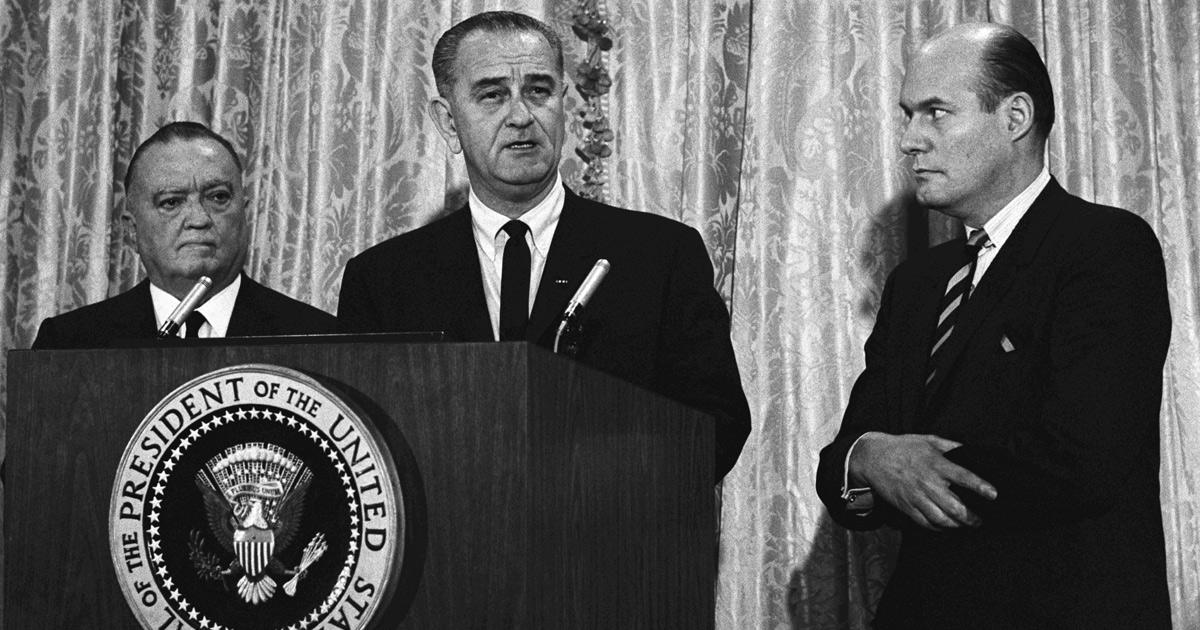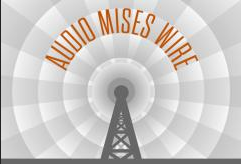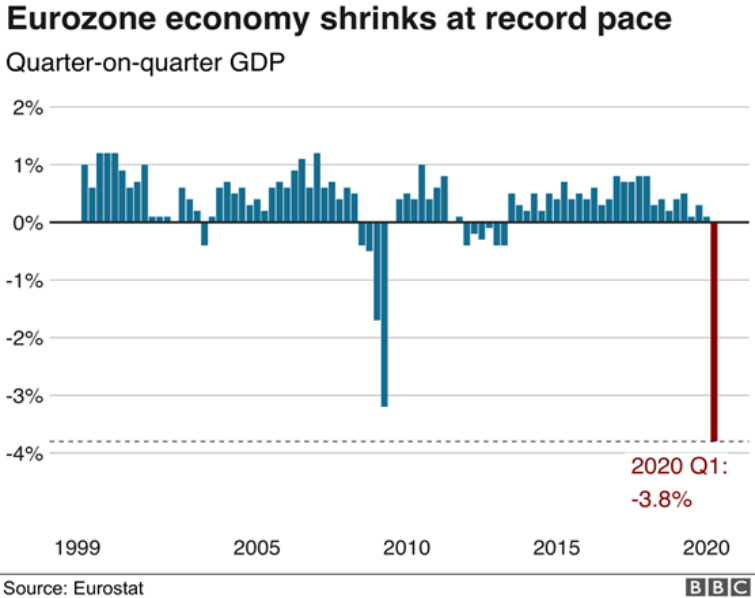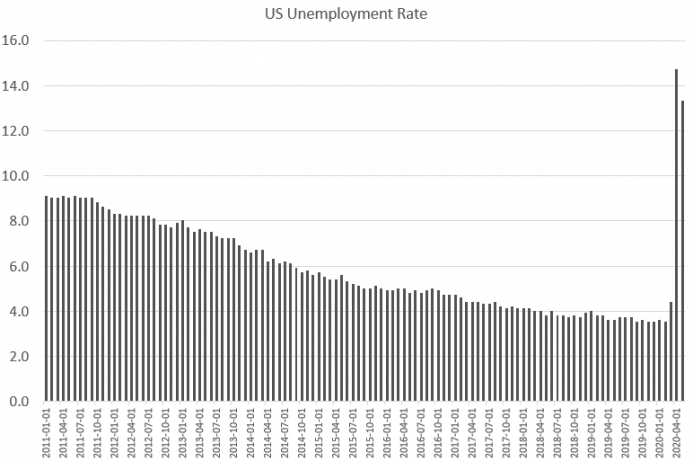. [Review of Amity Shlaes, Great Society: A New History (New York, NY: HarperCollins, 2019).] Most people associate the Great Society initiative with Lyndon Baines Johnson. There is very good reason for that, to be sure. As president, Johnson, the “master of the Senate,” was the driving force behind the raft of legislation that passed during his administration, the 1964 and 1965 legislation that framed and filled in his vision for a “great society” in which the blessings of postwar America’s bonanza would be shared by all. Johnson’s spearheading of the Great Deal initiatives in turn stemmed from his personal attachment to the New Deal. Johnson had been a Roosevelt stumper in Texas before finding his feet in Washington politics, and the desire to complete FDR’s
Topics:
Jason Morgan considers the following as important: 6b) Mises.org, Amity Shlaes, Featured, Great Society, Lyndon Baines Johnson, newsletter
This could be interesting, too:
Nachrichten Ticker - www.finanzen.ch writes Die Performance der Kryptowährungen in KW 9: Das hat sich bei Bitcoin, Ether & Co. getan
Nachrichten Ticker - www.finanzen.ch writes Wer verbirgt sich hinter der Ethereum-Technologie?
Martin Hartmann writes Eine Analyse nach den Lehren von Milton Friedman
Marc Chandler writes March 2025 Monthly
[Review of Amity Shlaes, Great Society: A New History (New York, NY: HarperCollins, 2019).]
Most people associate the Great Society initiative with Lyndon Baines Johnson. There is very good reason for that, to be sure. As president, Johnson, the “master of the Senate,” was the driving force behind the raft of legislation that passed during his administration, the 1964 and 1965 legislation that framed and filled in his vision for a “great society” in which the blessings of postwar America’s bonanza would be shared by all. Johnson’s spearheading of the Great Deal initiatives in turn stemmed from his personal attachment to the New Deal. Johnson had been a Roosevelt stumper in Texas before finding his feet in Washington politics, and the desire to complete FDR’s domestic legacy by positioning government at the center of a vast nationwide redistribution network was the motor of the Great Society as we know it today. President Johnson was a necessary condition for the Great Society programs that cleared Congress with remarkable regularity and became part of the federal bureaucracy. No Johnson, no Great Society.
But LBJ was not sufficient condition for the Great Society to arise. Former Wall Street Journal editorial board member and current King’s College scholar Amity Shlaes’s new book Great Society: A New History shows us that what we might think of as Johnson’s pet program was so much more than his baby alone. Shlaes’s biography of the idea of the Great Society reveals that it was planning in general—more precisely the article of faith that government could employ “the best and the brightest” to engineer its way over any obstacle that the mere unplanned world might throw at it—that was the Great Society’s true parentage (pp. 7–8). Johnson was without doubt the broker for the deals, public and private, that allowed the Great Society to take shape. But, for all that, Johnson was merely one of many at the planning table. It was faith in planning, not inherent greatness, personal or otherwise, that made the Great Society what it was. If nobody else in government had believed it possible to plan a great society, then all of Johnson’s efforts would have been in vain.
The phrase “the best and the brightest” calls to mind another president, of course. John Fitzgerald Kennedy, Johnson’s predecessor, had also thrown the weight of the federal government behind the planning regime. Shlaes remarks that Kennedy “court historian” Arthur Schlesinger noted, after a White House visit in 1963, the tension between Kennedy’s “New Frontier” space race planners and old-style liberals such as Johnson, for whom the Great Society was, as President Johnson would later put it, actually a “War on Poverty”—an attempt not only to defeat being poor, but to cure it as one would a disease (pp. 80–81). Both Kennedy and Johnson, then, had their own great societies in mind. However, both strains of great society planning, the technocratic and the bleeding heart, ended in similar failure. Neither the Kennedy nor the Johnson visions for how to use the power and riches that had fallen into America’s lap after World War II panned out. Shlaes’s narrative is of planning leading to abstraction, an increasing remoteness from the complexities and realities on the ground. “The New Deal created a forgotten man,” Shlaes writes. “The Great Society created more” (p. 14). No matter how it was tried, or who tried it—even the best and the brightest—Shlaes shows that planning broke on the shoals of the real world at every turn.
This was perhaps nowhere as evident as in the labor unions. Walter Reuther, longtime president of the Union of Auto Workers (UAW), is one of the major players in Shlaes’s narrative, at times even outstripping President Kennedy and President Johnson in importance to Shlaes’s arguments. Reuther held up the Scandinavian democratic socialist countries as the ideal that America should follow, and he spent his life planning for the lives of the army of workers under the UAW umbrella. But, to his chagrin, workers themselves often preferred to work in nonunion shops. They didn’t want their lives planned by someone else. “Since the passage of the Taft-Hartley Act,” Shlaes says, “Reuther and [American Federation of Labor-Congress of Industrial Organizations (AFL-CIO) president] George Meany had been running a race against time: companies were indeed moving [to states which had opted for Taft-Hartley provision 14(b) allowing] state governments to make working with unions optional for employers” (p. 67). Faced with competition from “right-to-work” states, Shlaes argues, “Reuther and Meany had to prove to workers that unionland offered a better life” (p. 68). Their solution was even more and more ambitious planning, but even Reuther was savvy enough to see that domestic bargaining and more centralized planning for unions alone were not enough. The generous pay packages that Reuther negotiated for UAW members could be undercut by overseas firms, so “throughout the 1950s and 1960s,” Shlaes points out, Reuther spent much of his time in Europe and Japan, imploring union workers there, too, to negotiate higher wages (pp. 68–69). Inevitably, planning bled over the borders of the United States. Once planning started at home, the planners would have to plan the rest of the world economy, too.
Planning is the motif of Shlaes’s Great Society. In the postwar era, America, which had been in the shadow of the Great Depression and two global conflicts over the previous thirty years, suddenly found itself rich. What to do with all the money was the big problem with which the planners were confronted. Shlaes’s book begins with Bonanza, the long-running (1959–73) TV show about a family that strikes it rich in the American West, and uses it as a backdrop for her story about how planners chased ways to make the real-life American bonanza permanent. But somehow uncertainty and then disaster creep in. The plans don’t work. Shlaes follows the Midasian procession of wealth becoming quandary along the way. The more the planners planned, Shlaes shows us, the more the bonanza slipped out of their grasp.
There were those who were against the planning, to be sure. Former Screen Actors Guild president Ronald Reagan, for example, got his start in politics by starring in prime-time pro–free market television programs sponsored by General Electric, whose antiunion executive Lemuel Boulware worried that unionism would thwart the creative power of American capital. Shlaes reminds us that GE’s founders, Thomas Edison and Charles Albert Coffin, “believed that the kind of company that sustained American capitalism was the company that stood aloof, that wore no harness, that came to no big negotiating table” (p. 27). This is a key point in Shlaes’s book, that capitalism works best, in fact works only, when not fettered by superfluous plans. “In the time of Edison and Coffin,” Shlaes continues:
there had been no business school, no military-industrial complex, no electrical workers’ union, and no federal income taxes….In the day the journalist Ida Tarbell had summarized the attitude of the GE pioneers: “Research must be free and where it pointed the way business must have the discernment, the ingenuity and courage to follow.” Only free researchers allowed serendipity to take them to unexpected discoveries. (pp. 27–28)
Later Shlaes details the rise of another great American firm, Fairchild Semiconductor, founded when Robert Noyce and Gordon Moore and other maverick engineers decided to forge a capitalist path free from government entanglement. Fairchild Semiconductor, which would later become Intel, proved the exception to the emerging rule, however. The “military-industrial complex,” which President Eisenhower had lamented just before leaving office, was too lucrative for most companies to ignore. It was far easier to join the state-capital paradigm than eschew it altogether.
The gravity field of government was everywhere, and it seemed to insinuate itself into everything. Those who absented themselves from the Fed-led planning scheme more often than not found themselves rendered irrelevant, overlooked. This even extended into race relations. For example, Walter Reuther helped bail the Reverend Martin Luther King Jr. out of a Birmingham jail, Shlaes notes, but that largesse came with a price. Reuther enlisted King’s help in keeping the civil rights movement a mainstream, union-implicated affair. The Great Society didn’t need any competition from actual black people in planning for black uplift. When the antiracist arm of activist Tom Hayden’s Students for a Democratic Society tried to get seats on the floor of the 1968 Democratic convention, convention planners denied them those seats (pp. 126–30). Robert Parris Moses, a militant civil rights fighter who had left his job as a math teacher to become a Freedom Rider in the South, was pushed aside, and Walter Reuther, working under direct orders from President Johnson, quietly strong-armed the rest of the civil rights leaders into following the union line (p. 127). There was too much at stake politically, Shlaes explains, to allow unplanned outbursts to imperil the 1968 Democratic National Convention—but then, of course, this convention now lives in infamy as the site of a much more violent outburst in the streets of the host city Chicago (pp. 292–99). Again, the way things were planned was not the way they ended up working out.
This slowly accelerating dervish of planning chasing the unplannable led to a bubble of costs which gradually moved from the peripheries to the center of the presidential day. The more plans failed, the more money it was going to take to fix things up. Shlaes shows how Johnson leaned hard on Federal Reserve secretary William McChesney Martin not to raise interest rates so that he, Johnson, could borrow more and more money making society great. Henry Hammill Fowler, Johnson’s Treasury secretary, warned Martin against raising the rate, but Martin did it anyway (pp. 199–200). Even this couldn’t preserve America’s credit rating, however, because, as Shlaes points out, it was by this point obvious to everyone that the US would have to end its currency’s relationship with gold. Gold was keeping the federal government from borrowing what it would take to spread the postwar bonanza around among all.
Veins of subterranean gold underpin much of Shlaes book. She follows the sources from the time to show that gold was on the minds of politicians and the general public alike. Even in the postwar American bonanza there was still uneasiness about how long the gold would last. Readers will remember Goldfinger, the 1964 James Bond movie about a crazed “foreign businessman” who plans to irradiate Fort Knox and thereby render the American gold supply unusable (p. 266). Shlaes reminds us that this was not entirely a figment of Ian Fleming’s imagination. There was no Goldfinger plot, of course, but the movie, Shlaes points out, was very timely social commentary. The convertibility of the dollar into gold, and the federally mandated level of gold reserves of at least 25 percent of circulating currency that had to be kept domestically at all times, were front-and-center international issues during the years when the Great Society was trying to find its feet (pp. 254–90). President Kennedy, Shlaes says, fretted constantly about the gold reserves, “almost like a Victorian banker,” daily asking his advisors how much was left in the vaults (p. 44). President Johnson had an even bigger problem as foreign governments began to call America’s bluff and withdraw gold, preferring specie in the hand to promises in the president’s mouth. As Shlaes pithily sums it all up, “Johnson was trading in the Great Dollar for the Great Society, and it was a lousy trade” (p. 270).
Here was the quandary. The Great Society was proving to be enormously expensive, and the more money the planners spent, the more the price of their planning kept rising. There seemed to be no way to plan around the surprises that kept cropping up, the unintended consequences of the plan. One of the people in Shlaes’s narrative who best brings this conundrum to life is Daniel Patrick Moynihan, the autodidact whiz kid who, having been helped out of poverty by government programs himself, wanted to extend the same opportunities to everyone else. To be sure, Moynihan’s real-world experience acted as a brake on the planning impulses of those, such as John F. Kennedy’s brother-in-law, Sargent Shriver, who saw the federal funding of welfare as an extension of the giving of alms. But even when done with Moynihanian restraint, planning tended to go awry. Shlaes reminds us, for example, that in 1965 Moynihan penned “The Negro Family: The Case for National Action,” which admitted the hard truth that welfare programs perversely tended to destroy black families, exacerbating poverty rather than “curing” it (p. 162). And Moynihan’s suggestion in favor of public sector unions was the impetus behind President Kennedy’s 1962 signing of Executive Order 10988, which extended collective bargaining rights to federal employees. This big change to the Wagner Act regime led to gridlock in municipal planning as unions captured Democratic Party machines, which initiated a cycle of successive administrations rubber-stamping union demands and unions duly sluicing a portion of dues into the coffers of Democratic candidates for office. Rent seeking was the only constant of the postwar period. Everything else was beyond prediction.
By the time Richard Milhous Nixon took office following Johnson’s decision not to seek reelection in 1968, the ability of the US government to plan its way into the future was in serious doubt. Beset by rising competition from industries in nations that had been bombed into oblivion during the war—nations such as Japan, where an entrepreneur named Toyoda Kiichirō (helped along by postwar programs pushed through by another great society visionary, General Douglas MacArthur) realized he could find a niche in the American market by making smaller, higher-quality cars than Detroit did—the US economy lurched (p. 302). The bonanza of the 1950s and the planning frenzy of the 1960s were both tapped out by the early 1970s. Nixon announced his decision to remove the US from the gold standard in 1971 as a way to fight the inflation caused by massive government outlays, signaling the end of the line for the Great Society as Johnson and other planners had conceived of it. It was no coincidence that Nixon made this announcement on August 15, the anniversary of the Japanese surrender in 1945, because decoupling from gold was Nixon’s tacit admission that America would have to maneuver to fight Japan again, this time from Detroit instead of from Washington.
Normally, narratives about the 1960s would track the progress of the Vietnam War. Much to her credit, though, Shlaes demurs. She might have followed the usual Shakesepearian line and portrayed the 1960s as a bright beginning darkened by a distant war, the walls of reality closing in as the government got the problems and solutions mixed up. But one of the strengths of Great Society is that Shlaes avoids easy theatricality, and pat answers in general. That is the whole point, after all. Her book reads as spontaneously as if we did not know what was going to happen next—unplanned. Even Henry Kissinger, who dominates most Vietnam-era histories, is given just a minor role, and this is entirely in keeping with Shlaes’s thematic treatment of the era overall. Instead, Vietnam becomes just one part of the Great Society debates at home. Shlaes follows Tom Hayden and socialist Michael Harrington on their journey to North Vietnam—Hayden and his second wife, Jane Fonda, later named their firstborn child “Troy, after the Vietnamese martyr [Nguyễn Văn Trỗi] who had plotted to kill McNamara”—but this was not so much about Vietnam as about the USA (pp. 224, 226). In Shlaes’s telling, it was not that Vietnam was dragging down the Great Society, but that planning could conquer neither poverty nor the North Vietnamese (p. 207).
Indeed, in a welcome narrative departure from other books of this kind, the antistrophe to Shlaes’s Bonanza motif is not Vietnam, but Pruitt-Igoe, the gigantic public housing project in downtown St. Louis, which Shlaes takes as emblematic of the rise and fall of the Great Society idea. Inspired by the planning spirit which saw social problems as kinds of math problems, codes to be broken, the planners in the federal government poured an extraordinary amount of money into breaking the code of poverty. Dismissing Moynihan’s earlier call for a kind of architectural brutalism in government buildings and hiring New Formalist architect Minoru Yamasaki instead, the government commissioned the Pruitt-Igoe complex. The hyphen is instructive. At the time, segregationalist policies meant that white and black poor people lived in largely separate communities. At Pruitt-Igoe, as with the federal busing schemes later introduced by the same planners, poor blacks and whites would live cheek by jowl, the Great Society in action, people’s lives planned from above. But the great tragedy is that this new federally mandated bonanza belonged to no one. Without ownership, Shlaes points out, nobody took care of the facilities. Vandalism was rampant, with copper flashing and gutters regularly torn out by thieves and sold for scrap. Elevators—which planners had designed to stop only at every third floor in order to encourage community building—were turned into latrines. Worse, the lengthened elevator rides often facilitated muggings and rapes. In 1972, the government blasted away half of Pruitt-Igoe, a symbol for many of the half-hearted execution of half-baked Great Society plans (pp. 220–29).
Amity Shlaes’s Great Society is a beautifully written, wry, and powerfully understated book about the disastrous era of full-scale government planning in the United States. Shlaes indulges in no editorializing—the facts of the time are more than enough to show the folly of the master plan. Apart from a few typographical hiccups and some very slight repetitiveness here and there, the book is ingeniously executed, motif layered on motif as Shlaes’s short, catchy sentences braid into the rope with which, by the end, most of the planners end up hanging themselves. At times, Shlaes’s exposition rivals that of Shelby Foote in its quiet assurance and playful asides. Even those who lived through this era of history and think they have seen all there is to see about the Great Society will want to buy and read Shlaes’s new book. It is a delight—and, perhaps, sadly, the best thing to come out of two decades of relentless government planning.
Tags: Amity Shlaes,Featured,Great Society,Lyndon Baines Johnson,newsletter









